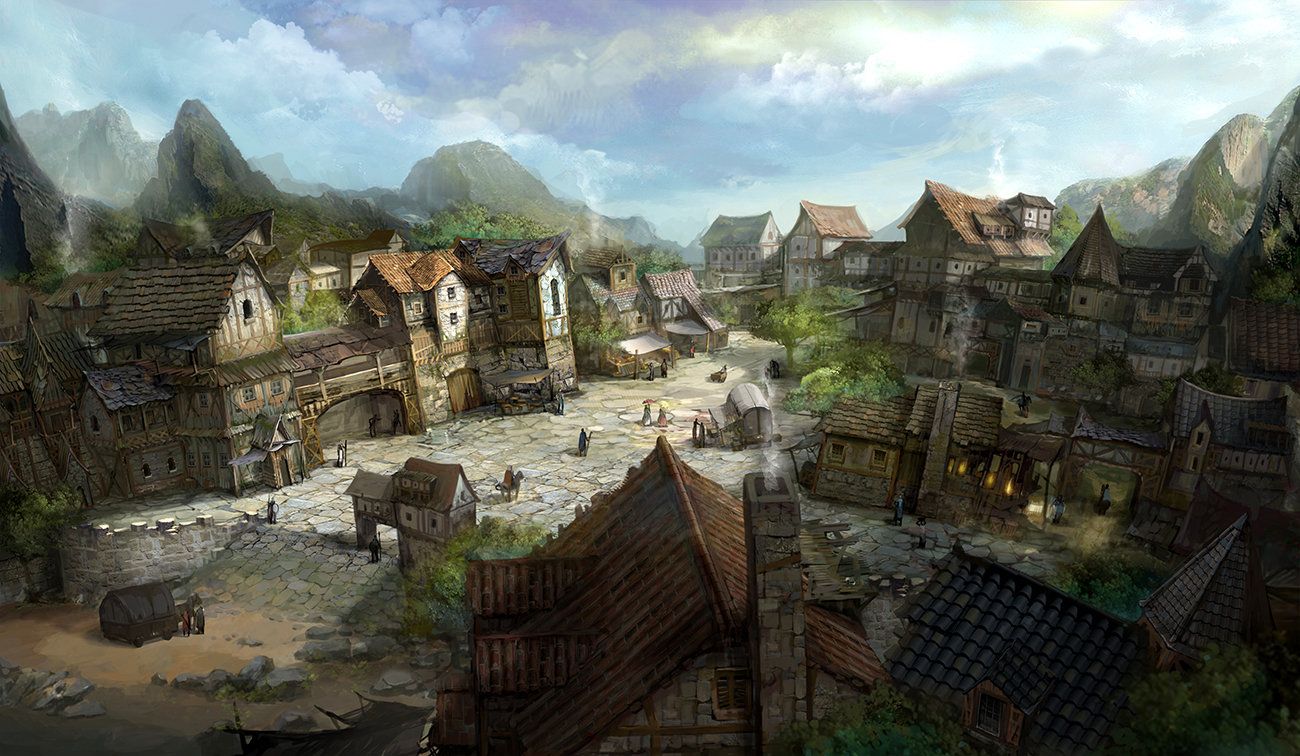Difference between revisions of "Town"
Tao alexis (talk | contribs) (Created page with "'''Towns''' are conglomerations of settlements and villages that have grown and gathered together for the purpose, first, of protection, and second,...") |
Tao alexis (talk | contribs) |
||
| Line 1: | Line 1: | ||
| + | [[File:Town.jpg|right|560px|thumb|A '''country town''' progressing from its core village to the accumulation of larger, abutting structures to the necessity of building a wall]] | ||
'''Towns''' are conglomerations of [[Settlement|settlements]] and [[Village|villages]] that have grown and gathered together for the purpose, first, of protection, and second, for economic regions. A small town of a few thousand people may be distinguished from a large village not only by its size, but through the citizens having the means, and the will, to build a permanent structure around their habitat for the sake of security. Until this is in place, the need for protection rises above every other concern; and once the town is transformed into a safe haven, economic interests are sure to take hold, eclipsing every local sentiment that a villager would possess. | '''Towns''' are conglomerations of [[Settlement|settlements]] and [[Village|villages]] that have grown and gathered together for the purpose, first, of protection, and second, for economic regions. A small town of a few thousand people may be distinguished from a large village not only by its size, but through the citizens having the means, and the will, to build a permanent structure around their habitat for the sake of security. Until this is in place, the need for protection rises above every other concern; and once the town is transformed into a safe haven, economic interests are sure to take hold, eclipsing every local sentiment that a villager would possess. | ||
Revision as of 05:14, 24 March 2021
Towns are conglomerations of settlements and villages that have grown and gathered together for the purpose, first, of protection, and second, for economic regions. A small town of a few thousand people may be distinguished from a large village not only by its size, but through the citizens having the means, and the will, to build a permanent structure around their habitat for the sake of security. Until this is in place, the need for protection rises above every other concern; and once the town is transformed into a safe haven, economic interests are sure to take hold, eclipsing every local sentiment that a villager would possess.
Townspeople are less concerned with the seasonal drama of the soil and growing things. Nature finds ways to assail the inhabitants, but they are free from nature's tyranny. It is life conducted with the aid of permanent shelters for protection and storage, reliable companionship with others, the constant reassurance of religion and state. Towns are concerned with the remaking of raw materials into instruments of urban living, by means of which money is made, which is spent upon the comfort, art and wisdom of the individual's daily materialistic routine. Unlike the village, every day is not the same; the deeply rutted ways of the village are abandoned; all is bustle, rush, the appearance of new things that arrive by ship or caravan.
Yet a town falls short of a city; its main energies are yet consumed with the marketplace, with gathering things in from the outside, with collecting and making and shipping forward. Business is not yet transformed into finance; fabrication falls far short of creation. Occupation is a dim substitute for society, culture, heritage, learning and creativity. The town has grown beyond the village, but it has not yet matured; it does not yet possess wisdom.
The Growth of Towns
Up until the Norse invasions, the monastery served as a secure haven. Communication was carried out between monasteries and regional lords, while backward villagers dwelt in the monastery's shadow. From the monasteries came alms, and news of the outside, and opportunities for selling some small part of one's agricultural goods. Within monasteries, the arts of bookbinding, glass making and decoration were carried on, none of which crept into the lower villages, who were many times removed from the lives of monks.
Markets arose because they served the feudal lord or the monk. Providing a market for goods, and a mint to stamp coins, enabled the collection of goods and taxes. This formed a new urban foundation. Market privileges were granted to persons able to pay for them — most often religious persons. Villages with the "market cross" became points on a network of trade; traders became a new class, who gained special privileges through new laws. Villages permitted to sell gathered converts; trading villages collected vassal subordinate hamlets, that grew themselves on the fat that fell from the village's table. An increase in population and wealth, particularly in villages that acted as stepping stones along the most important routes from China to Europe, laid the foundation for international capitalism. Walls rose around conglomerations of people and select orchards, vinyards and water sources, separating towns from the country. In these places, producers count for 80% of the population. The remaining income is enjoyed by those who "hold" buildings and land in exchange for cash rent. By the 14th century, with exceptions, feudal lords and nobles had supplanted the monasteries, outnumbering them in the desire to create urban centers that would raise taxes for the equipping of soldiers and ships.
